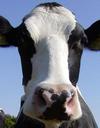Crossbreeding is the key for cattle

Health and vigour in dairy cows can be improved using crossbreeding techniques. Scientists at the Faculty of Agricultural Sciences will examine the practical implications of this.
Pigs do it. Chickens do it. But Danish dairy cattle do not � at least not to the same extent.
The issue here is crossbreeding. Although this method of breeding is extensively used in pig and poultry production, because it more often than not leads to improved production results, it has rarely been used on Danish dairy farms. Researchers from the Faculty of Agricultural Sciences (DJF) at the University of Aarhus now intend to change that.
The word heterosis describes the concept of improving the vigour of offspring comparative to the parents through crossbreeding. Heterosis often works best on traits of low heritability that relate to the survival of the species. This may be traits such as fertility, vigour and health. The breed of the cattle involved is also important, as the degree of heterosis varies according to which breeds are crossed.
Senior adviser Morten Kargo S�rensen from the Department of Genetics and Biotechnology at DJF explains:
- There is a strong tradition for purebreds in cattle. That is one of the reasons why crossbreeding has not really caught on. Cows also have fewer offspring per year than both pigs and poultry. This means that crossbred animals themselves have to be included in further breeding initiatives, if systematic crossbreeding programmes are used for cattle. This reduces the benefit of crossbreeding somewhat.
Nonetheless, there are so many advantages to crossbreeding that it is worth while making as wide use of it in cattle breeding as possible. Crossbreeding results in more vigorous and robust animals, thus improving the economy of dairy farmers.
Data material to be updated
The largest crossbreeding experiments with dairy cattle took place in Denmark in 1988. Since then there have, however, been improvements in all breeds and this is bound to result in changes to heterosis figures.
A comprehensive study is therefore under way to examine the degree of heterosis for each of the traits that are targeted in the Danish dairy cattle breeding programme and also which combinations of breeds work best. The study will be using cows from working farms.
- It is important to know the degree of heterosis for each trait when you are comparing the purebreds in the evaluation. In addition to using crossbreeding, it is incredibly important to maintain the breeding improvements obtained for the individual breeds � otherwise crossbreeding just would not be worthwhile, says Morten Kargo S�rensen.
Scientists will also investigate whether the degree of heterosis is environmentally dependent. Some results indicate that heterosis is more pronounced in a stressful environment, such as in high-yielding herds.
- With an updated dataset, we are better able to sell the idea of crossbreeding to farmers and to advise on which breeds are most suitable for crossbreeding purposes, irrespective of which traits you are aiming for. This gives a better decision-making tool. I hope that a larger number of livestock farmers will benefit from the extra income which systematic crossbreeding can give, says Morten Kargo S�rensen.
For further information please contact:
Senior adviser Morten Kargo S�rensen, Department of Genetics and Biotechnology, telephone: +45 8999 1264, e-mail: [email protected]


 Tel: +45 8999 1900
Tel: +45 8999 1900